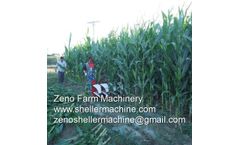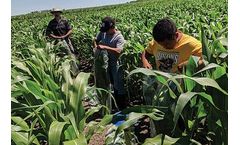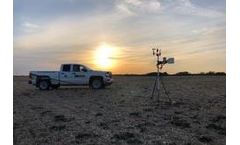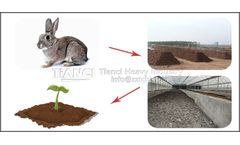Fertilizer Input Articles & Analysis: Older
21 articles found
Along with that, it needs large scale farms, modern technologies, innovative farm machinery, good irrigation methods, chemical fertilizers etc. to produce a high yield. Commercial farming has the main feature consisting of modern inputs for higher productivity like good fertilizers, pesticides, weed killers and many more. ...
Soil moisture is not only important for crop production, input decisions and yield outcomes – it is an important determinant of runoff volume, flood risk and greenhouse gas emissions from agriculture soil, such as nitrous oxide (N2O). ...
” The data that our Crop Intelligence app provides and the support that our team offers helps you inform your planning and decision-making—both in-season and before next season. Fertility planning Fertilizer inputs represent a significant portion of a farm’s total cost of production. Knowing your crop available water and ...
The particle shape is helpful to slow-release the fertilizer effect and improve the practicability of the organic fertilizer of the rabbit manure. ...
Flat die organic fertilizer granulator production line Organic fertilizer is rich in organic matter and nutrients. ...
“They do not require costly inputs of fertilizers or pesticides, and produce better quality straw for cattle feed and roofing of ...
ByEnsia
Growth and yield parameters were significantly superior in the pots treated with live earthworms as compared to other fertiliser inputs at 5% level. The plant height was recorded 71.12 cm, maximum fruit weight 900 g, time taken in budding and flowering 32 and 39 days, consecutively and number of fruits 100 in live earthworm + cattle dung treated plants. ...
The effects of herbicide, insecticide, and fertilizer inputs on the common buttercup Ranunculus acris in field margins were studied in an experimental field study. The test design allowed us to investigate the single and combined effects of repeated herbicide, insecticide, and fertilizer applications in successive growing seasons. To assess the ...
Location Pfaffendorf/Germany Capacity 2 x 500 kWel In operation since 08/2004 and 09/2007 Input materials Flotate fat, cattle liquid manure, DDGS, waste from biodiesel production Features The farming enterprise now utilises all fermentation residues as valuable fertiliser. The input materials used in the biogas plant in Pfaffendorf are limited to animal fats from butcher's shops and ...
As concerns about N pollution continue to mount, the sensors offer a way to cut fertilizer inputs without hurting yield or profits. “The most important thing, I think, is that we were able to make progress on both fronts: The technology slightly improved production and slightly improved environmental outcome,” says the study’s leader, Peter ...
SCIENTISTS at an environmental biotechnology company have developed a biological product that could potentially be used to directly reduce the amount of nitrogen and other fertilisers used by arable farmers. Amnite® A100, created by Stockton-on-Tees-based CBio (Cleveland Biotech), relies on an improved symbiotic relationship between plants and soil microbes - by increasing and improving ...
This study investigates long-term tillage effects (moldboard plow, and deep and shallow chisel plow) and their interactions with N fertilizer input on yields and economic performance in a corn (Zea mays ...
We conducted direct measurements of a wide range of N pools and fluxes for a 2-yr period, including soil N mineralization, soybean N2 fixation, tile and river N loads, and ground water and in-stream denitrification. Fertilizer N inputs were from a survey of the watershed and yield data from county estimates that were combined with estimated protein contents to ...
Merr.], or 4-yr rotation (C-S-W/A-A) with soybean, wheat (Triticum aestivum L.), and alfalfa (Medicago sativa L.) under different N input levels. We evaluated N fertilizer input (8.5 or 5.3 Mg/ha yield goal, or no N) and crop rotation (C-C, C-S, or C-S-W/A-A) treatment effects on soil minerals (N, P, K, S, Ca, Mg, Fe, Mn, and Zn) and their ...
Leguminous cover crops (CCs) may reduce N fertilizer requirements by fixing N biologically and storing leftover N-fertilizer applied in the previous year. ...
Across-site analysis indicated that the manured treatment increased corn (Zea mays L.) yields significantly (alpha = 0.05), by 0.5 Mg ha–1 (11.5 vs. 11.0 Mg ha–1), with 67 kg ha–1 less purchased fertilizer N during the 3 yr of this study. However, there were environmental concerns: (i) Early fall manure spreading significantly increased fall nitrate (NO3) levels in the manured ...
According to available data in the literature, phosphorus fertilizer inputs (2–10 kg ha–1) slightly exceed the estimated outputs of phosphorus in clippings (0.4–7.5 kg ha–1). Sediment losses from turf areas are negligible, generally limited to establishment, but runoff and leaching losses of P vary from inconsequential to severe depending on rate, source, and ...
Nitrogen fertilization of turfgrass continues to be scrutinized due to environmental concerns. Practices that reduce fertilizer inputs without sacrificing turfgrass quality are needed, but a reliable test of N status in turfgrass is not currently available. ...
A diversified crop rotation may reduce fertilizer N inputs for corn (Zea mays L.) and increase soil organic C (SOC). Our objectives were to determine the effects of crop rotation and fertilizer N on soil C within the surface soil (0–15-cm depth). Rotations were started in 1990 on a Barnes sandy clay loam near Brookings, SD. ...
We conducted direct measurements of a wide range of N pools and fluxes for a 2-yr period, including soil N mineralization, soybean N2 fixation, tile and river N loads, and ground water and in-stream denitrification. Fertilizer N inputs were from a survey of the watershed and yield data from county estimates that were combined with estimated protein contents to ...











